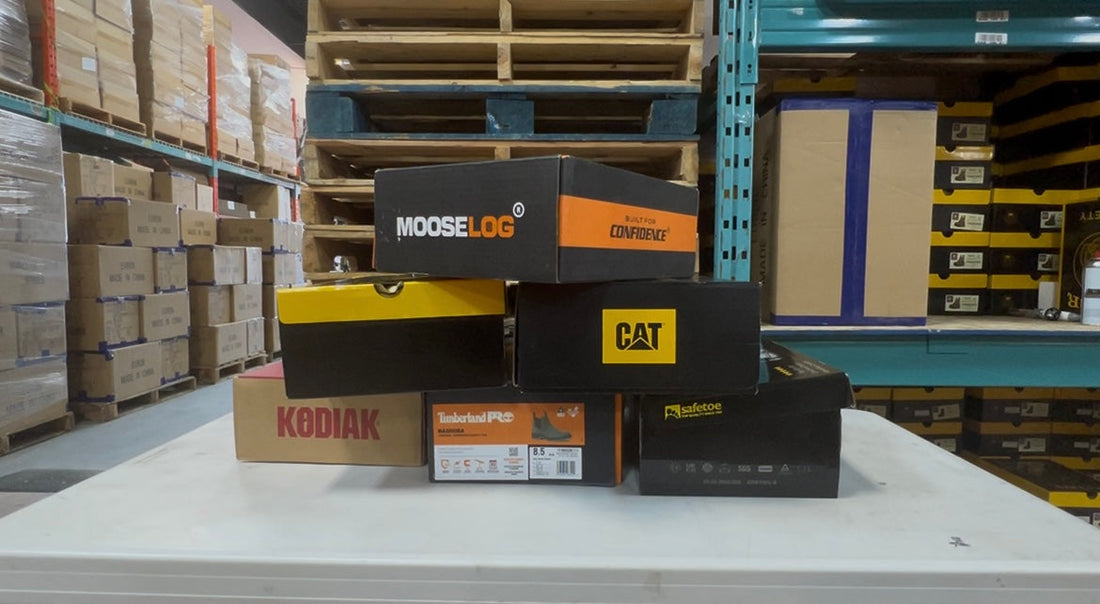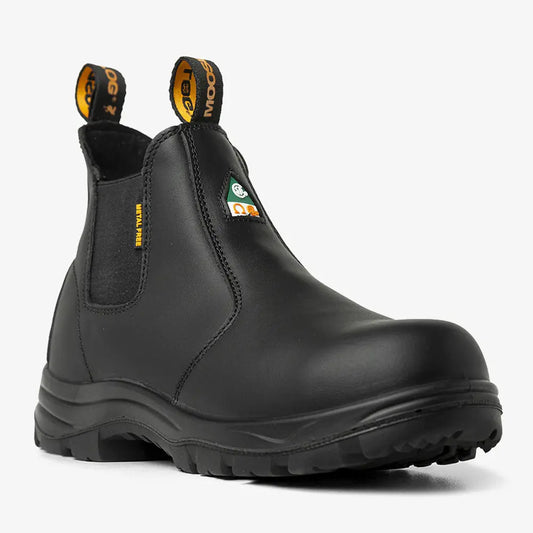
The Ultimate Guide to Choosing CSA-Approved Safety Shoes & Work Boots
1. What is CSA?
CSA stands for the Canadian Standards Association, and when it comes to work footwear, CSA certification means your boots or shoes meet nationally recognized safety standards so that they’re jobsite approved.
Workplaces across Canada often require CSA-approved safety shoes or work boots by law, especially in industries like construction, manufacturing, utilities, and transportation.
Understand the CSA Symbols First
Before buying CSA approved boots, start by learning what the certification symbols mean. These markings are found on the boot tag or label and indicate the type of protection provided.
- Green Triangle: Indicates a Grade 1 protective toe cap (withstands 125 joules of impact and 15 kN of compression) and a puncture-resistant sole. The sole is tested by applying a 270 kg (600 lb) force to a 4.5 mm diameter nail. This symbol is required for construction, heavy manufacturing, and other high-risk industrial environments.
- White Rectangle with Ω Symbol: Signifies Electrical Shock Resistant (ESR) footwear. The outsole is designed to prevent electrical current from passing through the body in dry conditions. During testing, the boot must withstand 18,000 volts at 60 Hz for one minute with a leakage current of no more than 1 mA. Ideal for electricians or those working near live circuits.
- Yellow Rectangle SD: Identifies Static Dissipative (SD) footwear, designed to reduce static build-up. These boots allow limited electrical flow through the sole to safely discharge static electricity into the ground, protecting sensitive equipment. SD footwear is tested to maintain electrical resistance between 1 megaohm and 100 megaohms.
- Yellow Rectangle SD+: Represents enhanced static dissipative protection, with tighter control over the electrical resistance range. These boots are tested to ensure resistance stays within a more precise window, making them suitable for advanced ESD-sensitive environments like electronics manufacturing or clean rooms.
- Dark Grey Rectangle with M: CSA-approved metatarsal protection, guards the top of the foot from heavy impact. A weight is dropped onto the metatarsal guard. To pass, the boot must prevent the force from crushing the top of the foot and maintain a safe clearance underneath.

Always choose a boot that displays the symbols required by your jobsite or employer. If in doubt, the Green Triangle + White Rectangle is a strong all-purpose choice for most outdoor and industrial work.
2. Safety Shoes vs. Work Boots: What’s the Difference?
When shopping for CSA-approved footwear, you’ll come across both safety shoes and work boots. While they offer similar protection, they’re built for different job environments.
Safety shoes are usually low-cut and lightweight, ideal for indoor jobs like warehousing, manufacturing, or logistics. They provide certified toe protection and may include EH or slip resistance, but they’re designed for mobility and all-day comfort.
Work boots, on the other hand, are more rugged. With higher cuts, puncture-resistant plates, and durable outsoles, they’re built for outdoor worksites, like construction, oil and gas, or heavy trades. Many models are also waterproof and heat-resistant.
Both meet CSA standards. Just choose based on your work conditions and required safety features. Which brings us to...
3. Understand Your Jobsite Requirements
Choosing the right CSA-approved safety shoes or work boots starts with knowing what hazards you face on the job. Different worksites demand different types of protection—and not every boot is built for every trade.
Composite Toe vs. Steel Toe
If toe protection is required, your boots need a CSA-certified safety toe. The two main types are steel toe and composite toe:
- Steel toe boots offer maximum impact protection but tend to be heavier and conduct temperature.
- Composite toe boots are made from non-metallic materials like carbon fibre or Kevlar. They’re lighter, don’t set off metal detectors, and offer better insulation in cold environments.
Puncture Resistance (Green Triangle)
If your job exposes you to sharp objects like nails, metal scraps, or broken glass, you’ll need CSA work boots with a puncture-resistant plate. This feature prevents injuries from objects piercing the sole and is marked by the green triangle label.

Electrical Hazard (EH) Protection
Working around live wires or electrical panels? Look for EH-rated boots with CSA’s white square/Ω symbol. These boots are designed to prevent electrical current from passing through to your feet in dry conditions.
Slip & Oil Resistance
Slippery floors and oily surfaces are a major hazard in warehouses, kitchens, maintenance shops, and manufacturing plants. Always check that your safety shoes or boots have slip-resistant outsoles—especially those tested and certified under CSA standards.
The job you do should always shape the boots you wear—because the right pair means fewer risks, more comfort, and no issues on site. Not sure whether you need steel, composite, or maybe even alloy toe? Check out our full breakdown here.
4. Key Features to Look For in CSA Work Boots or Safety Shoes

Once you've covered the safety basics, the next step is making sure your boots will hold up to daily wear and keep you comfortable on the job. Certification matters, but the right features make all the difference over a long shift.
Comfortable insoles and midsoles
If you're on your feet all day, you need proper cushioning. Look for memory foam, PU, or other shock-absorbing materials that support your foot and reduce fatigue. Boots with removable insoles give you the option to switch them out based on your needs.
Ankle support
Outdoor work or uneven ground often calls for mid or high-cut boots with more support around the ankle. If you work indoors and need mobility, a low-cut safety shoe might be the better choice.
Breathable lining
Moisture-wicking fabric linings help manage sweat and prevent odour. For hot environments or long hours, breathable boots make a noticeable difference in comfort.
Water resistance
If you deal with wet conditions, water-resistant or waterproof work boots can keep your feet dry and reduce the risk of blisters or cold exposure. For dry indoor work, this feature might not be necessary.
Durability
Look for solid materials like full-grain leather, double stitching, and outsoles that resist wear. A durable boot lasts longer and performs better under tough conditions.
The right pair of CSA safety boots or shoes should protect you, support you, and hold up to the demands of your workday. Focus on build quality, comfort, and function, before the brand name.
5. Get the Right Fit: Why Sizing Matters

Even the best CSA-approved boots won’t do much if they don’t fit properly. A poor fit can lead to sore feet, blisters, or long-term foot and joint pain. Worse, it can even compromise safety if your foot shifts inside the boot during work.
Here are a few tips to get the right fit:
Try boots on at the end of the day. Your feet swell after a full shift, so sizing up at the right time helps avoid a tight fit later.
Wear your actual work socks. Always try on boots with the same type of socks you wear on the job. Thick or moisture-wicking socks can make a noticeable difference in fit.
Check the toe box and heel. Your toes should have just enough room to wiggle, without touching the front. Your heel should feel secure without slipping.
Don’t assume your size is the same across brands. Materials, construction, and safety toe types (especially composite vs. steel) can affect fit. Always double-check sizing charts or try them on if possible.
Getting the right fit helps prevent injury, improves performance, makes sure the protection features actually work as intended, and most importantly is comfortable so you can carry on long shifts without distraction, pain, or fatigue.
New boots feeling stiff? A proper break-in period can make all the difference. Here’s how to break in your work boots the right way.
6. Common Mistakes to Avoid When Buying CSA Footwear
Even with the right labels and specs, it’s easy to get the wrong boots if you’re not thinking about the full picture. Here are some mistakes buyers make that go beyond just safety ratings.
Not thinking about your work environment beyond safety codes
Just because a boot is CSA-certified doesn’t mean it’s right for your specific site. Think about weather, terrain, standing time, and how much walking you do—not just the symbol on the tag.
Assuming all CSA boots are uncomfortable
Some people settle for stiff, heavy boots because they think that’s just the trade-off for safety. But there are plenty of CSA-approved options that offer proper support and flexibility if you look for the right features.
Wearing the wrong socks
Sounds minor, but thin, worn-out socks can ruin the fit of a good boot. The right socks make a big difference in cushioning, temperature control, and how the boot fits over time.
Not replacing worn-out boots soon enough
CSA approval doesn’t last forever—if the sole’s worn down or the toe cap is damaged, that boot’s no longer safe. Don’t wait until they fall apart to replace them.
Overlooking how the boot will feel after 10 hours
A quick try-on doesn’t tell you much about long-term comfort. The real test is how your feet feel after a full shift. If the boot feels tight, heavy, or stiff right out of the box, it might not be the right choice for long days on your feet.
For even more tips our safety boot guide has all the answers from advice on fit, features, certification, and how to choose the right pair for your work.
7. Final Thoughts
Finding the right CSA-approved safety shoes or work boots takes more than just spotting the green triangle. Throughout this guide, we’ve covered what CSA certification actually means, how to read the symbols, and why those details matter on real job sites. We’ve looked at the difference between safety shoes and work boots, how to choose based on your environment, and what features actually make a pair worth wearing for ten or twelve hours at a time.
Fit, comfort, and long-term performance are just as important as compliance. Paying attention to toe protection, puncture resistance, slip ratings, and overall build quality can save you from a lot of problems later on. So can wearing the right socks, sizing properly, and taking time to break in a new pair.
A certified boot isn’t automatically a good one. What matters is how well it fits your job, your feet, and the way you work. If you know what to look for, it’s easier to avoid bad buys and get something that holds up. Find a pair that works hard with you, not against you.
If you're ready to shop CSA-approved footwear that’s built for real job conditions, take a look at our collection here.




